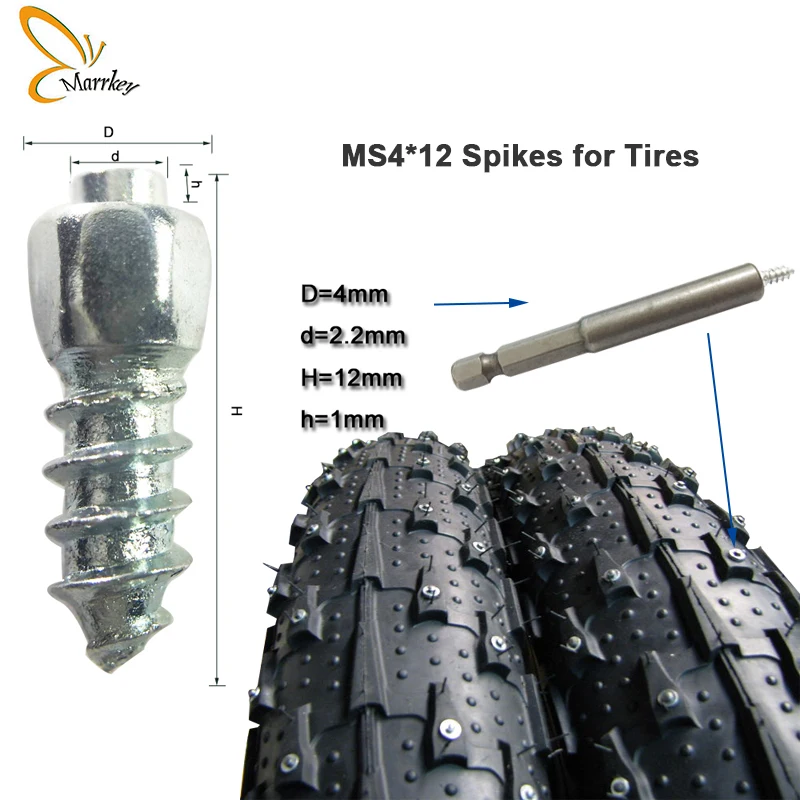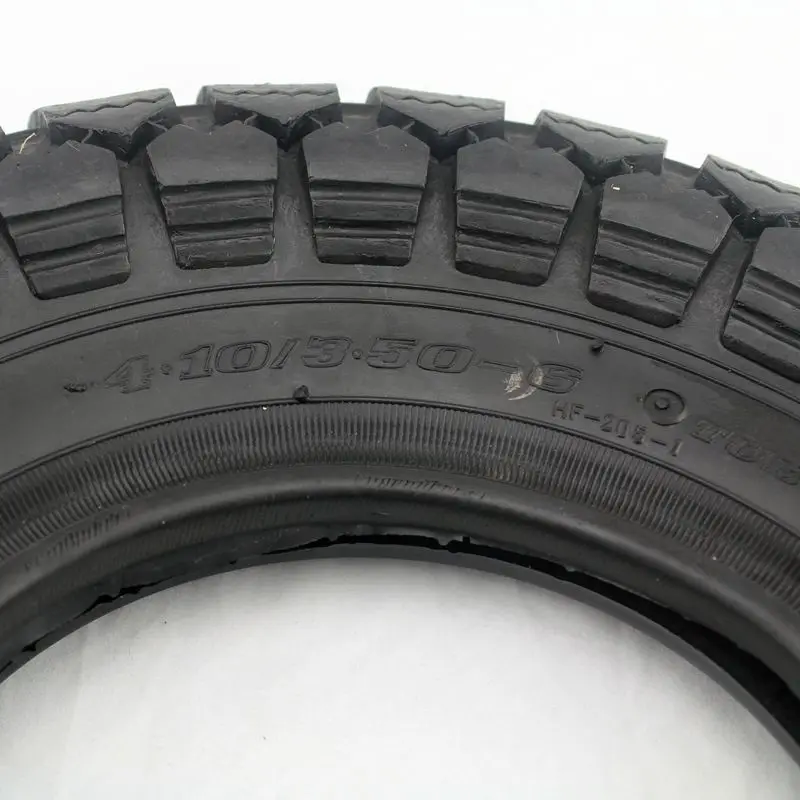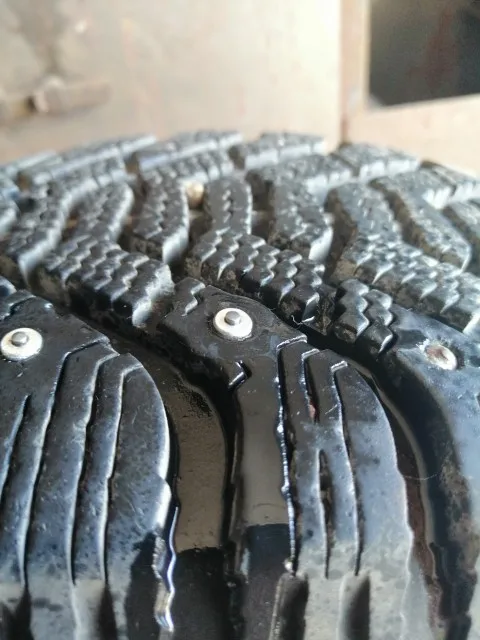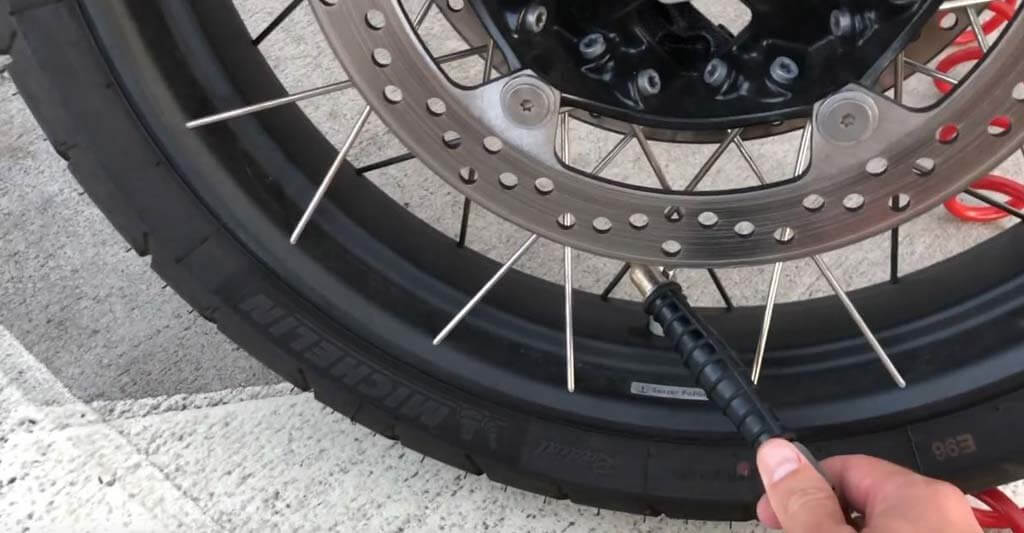If you’re looking for a reliable way to drive during the winter you’ve likely heard of tire studs, but they’re not a straightforward solution.
Tire studs have specific conditions in which they work best, others where they pose a risk and best practices for installation, maintenance, and more, all covered below!
Tire studs are small metallic spikes or protrusions fitted onto the tread, usually in the winter, to make driving on slippery roads easier. They come in different sizes and can be fitted depending on the tire’s tread. You can get studded or studdable options according to how handy you are with vehicle parts and accessories.
If you want to learn more about tire studs, including how they work, what size you need, whether or not you can remove/replace them, keep reading!
Tire studs are intended to break through the ice to give the tires more improved grip and traction for better vehicle control on slippery roads.
However, do they actually make a difference?
Well, this depends on the surface on which the vehicle is being driven while the studs are installed.
Their effectiveness is most noticeable when driving on ice as they’re built to break through for grip and traction.
On snow, however, they lose out to tire chains – designed to give your tires more surface to grip the snow – as the surface isn’t rigid enough for the studs to break through and create a solid anchor that stabilizes the vehicle.
Moreover, when the roads they’re being used on are just wet (for example from rain) or completely dry, they actually decrease traction and worsen control; think of it as running on smooth bathroom tiles with football cleats.
Due to their nature, it’s recommended that studs be installed onto thick tires. A good rule of thumb is to avoid tires with single-digit readings on the tread depth gauge.
Experts recommend installing studs on winter tires as they’re usually more readily adapted for them e. g. by being thicker and more resistant to stiffening in lower temperatures.
g. by being thicker and more resistant to stiffening in lower temperatures.
You can but based on the pointers above, it’s not a good idea to install studs to used tires, as they could have worn to the point where they can’t support them as efficiently and this unreliability could pose a risk.
If you consider yourself an expert, this comes down to the cost of acquiring the tools.
Tire studs are usually sold in packs of 100, ranging from $10 to about $50 depending on size and build material.
To fit them onto the tire, you would need a stun gun or drill – the latter is best for screw studs – both of which cost a few hundred dollars each.
If you’re not experienced enough with this, it’s best to seek professional services in order to avoid causing potentially fatal damage such as accidentally puncturing the tire.
Most auto shops will stud your tires for $15 per tire, and this covers the whole process, including labor and materials.
How long studded tires last depends on factors such as how often they’re used, what conditions they’re used in, the weight of the vehicle, etc.
Most industry professionals and manufacturers, however, recommend that you swap out your studded tires every four seasons.
It is possible to remove studs from your tires right at home using lubricant and a set of pliers, but only after unmounting the wheels from the vehicle first.
Lubing up the studs beforehand ensures that they pop out smoothly without rupturing the surface and causing a puncture.
You should use the same lubricant you use when mounting the wheels so you don’t end up with something that affects the rubber.
A good set of pliers should be used to grab the top of each stud and gently twisting it out instead of pulling.
While it is safe to remove studs from tires, a lot of care should be applied to the process and, in most cases, should be left to a professional.
For starters, after removing studs, make sure you check for punctures. Each tire could carry up to 100 studs, so ensure you’re thorough during this step.
Tires whose studs have been removed don’t tend to last as long, especially if they’re winter tires that aren’t adapted for use outside of very low temperatures.
To avoid any unforeseen issues that could result from this process, it is best that you keep the studs on the tires and instead swap the tires themselves out.
This way, you can have a set of wheels for the different seasons and when winter rolls back around, all you have to do is install the dedicated set of wheels.
Tire studs can be replaced but, as discussed above, it’s not a recommended move. Keep one set of studs to one set of tires and only install the tires during the appropriate seasons to ensure you get the most use you can from them.
Most of the tire studs available today have a stem made from steel or aluminum and a head made from tungsten to ensure they last as long as possible.
All these materials are highly durable, so if you find that they’re breaking off, it’s more than likely because they’ve been overused. In this case, they should be replaced as soon as possible to avoid motor accidents.
It could also indicate that they’ve been used on the wrong surfaces such as dry asphalt. Keep in mind that they’re meant primarily for icy roads and anything else that sacrifices control could put the driver and passengers in danger.
Tire studs are regulated by region, and it’s important that you check your local laws before installing them.
Most jurisdictions restrict their usage only to certain months within the winter. For example, in the U.S., only six states permit their use throughout the year (New Mexico, Wyoming, Colorado, Kentucky, New Hampshire and Vermont).
Other countries permit their use but with strict regulations of season and vehicle weight, including Denmark, Finland, Russia, France, Great Britain, Switzerland, Sweden and Turkey.
Some countries like Belgium, Poland, Portugal, Hungary, the Czech Republic and Luxembourg have outright banned their use.
Due to how we’ve established they work, tire studs are known to cause damage to road surfaces outside of the winter.
Because of the damage they can cause to roads, tire studs are illegal in some states and countries.
This comes down to where you drive your vehicle during the winter. If your regular commute involves icy roads, studded tires could be a better choice for you.
Regular winter tires, however, are enough for most people who only need to drive over snowy roads.
Apart from the aforementioned loss of traction on non-icy roads, studded tires are also noticeably noisier than winter tires.
An icy path is the one place where studded tires get a chance to really prove their worth, and this includes black ice.
They break through it to give the vehicle better grip and traction where the tire’s rubber would be inadequate.
Having an all-wheel-drive system could convince you that it’s enough year-round, but it’s better to be safe than sorry.
While AWD would provide more power than other systems, during more extreme conditions, traction would be harder to generate so winter or studded tires could come in handy.
Outside of these seasons, though, it’s probably a bad idea to keep the tires on the vehicle as the decreased traction puts a greater strain on the entire system.
When choosing studs for your tires, you should use a tire depth gauge to measure how much tread you have.
If you already know how to take readings from a gauge, finding the right stud size is as easy as getting one whose number corresponds to the first part of the reading.
For instance, if you find the tread depth to be 14/32″, go for a TSMI #11 size stud, if it’s 15/32″, go for a TSMI #15 stud and so on.
Some winter tires can be studded but it’s possible to use them without installing the studs beforehand.
If you are looking to know more, you can also see our posts on what are tire socks, which tires do you put chains on, and how long do winter tires last.
Tire studs provide better grip and traction on icy roads during the winter and they also work on black ice.
However, they should be used with caution and you have to look carefully into them before making your choice.
They’re best suited for use on roads that have been impacted by harsh weather conditions but could potentially be dangerous on regular snow, wet roads or dry asphalt.
Removal and replacement are generally discouraged; you should have a dedicated set of tires for these seasons and you can expect to get four seasons’ worth of normal use before needing to get a new one.
Researchers from Chalmers University of Technology, Sweden, have now shown that studded winter tyres cost more lives than they save. The new study takes a holistic view of the tyres' impact on wider public health. At the same time, they show that their use contributes to the bloody conflict in the Democratic Republic of Congo, and fatal accidents in their production phase.
The new study takes a holistic view of the tyres' impact on wider public health. At the same time, they show that their use contributes to the bloody conflict in the Democratic Republic of Congo, and fatal accidents in their production phase.
This is the time of year in Sweden when many people start to change their normal car tyres to winter ones. According to Trafikverket, the Swedish Transport Administration, around 60% of Swedish drivers choose studded winter tyres, and there has long been a debate about the emissions caused by the studs damaging the ground and throwing up particles into the atmosphere.
Three Chalmers researchers have now investigated this question. Anna Furberg, Sverker Molander and Rickard Arvisson at the Division of Environmental Systems Analysis used a systemic perspective to analyse studded winter tyres' public health impact for their whole life cycle.
To weigh up the advantages and disadvantages, the researchers looked at how many lives are saved through their use, compared to the level of emissions they generate through wear of the roads and in their production. Additionally, they investigated accident statistics from the small-scale mining industry in the DRC, where cobalt -- an important element for the studs -- is most abundant. Cobalt is a highly sought-after conflict metal which contributes to the warfare in the region, something the researchers also accounted for.
The researchers estimate that from a broader life cycle perspective of studded tyres' life-spans, Swedish use of studded tyres saves between 60 and 770 life-years, compared with 570 to 2200 life-years which are lost.
"Taking everything together, the picture is very clear -- studded winter tyres actually cost more lives than they save," says Sverker Molander, a professor at the Department of Technology Management and Economics at Chalmers.
advertisement
The biggest negative impact is generated during usage, from the emissions caused by road damage. Even taking only this into account, the negative health impacts already clearly outweigh the advantages. Once you measure the other factors in as well, the result only becomes clearer, the researchers explain.
"The small-scale mining, where many accidents and fatalities occur, is the next biggest part of the tyres' overall negative health impact. Deaths linked to the conflict in the DRC are the smallest part, but that being said, there are many aspects of that that have not been included in the study -- the conflict of course influences the whole of society. I doubt many people realise that using these tyres is contributing to the situation in the DRC," says Anna Furberg.
The advantages of the studded winter tyres are mainly enjoyed in Scandinavia, whilst nearly a third of the negative health impacts are felt elsewhere.
"This is a clear illustration of what globalised production can result in. People profiting at others' expense. It is not those who benefit from the product who are having to pay for the negative effects," says Sverker Molander.
So how should consumers react to this research? Anna Furberg and Sverker Molander suggest that good winter tyres without studs can be an alternative, in combination with careful driving and consideration of alternative means of travel.
"Of course, how you drive is important, and snow-ploughing and sweeping needs to be done properly. Most cars today also have electronic anti-skid systems fitted, which make them safer to drive at higher speeds. But our study shows that there is more research needed concerning alternatives to studded winter tyres that don't cause these health issues," says Anna Furberg.
The article "Live and let die? Life cycle human health impacts from the use of tire studs" was recently published in the scientific journal International Journal of Environmental Research and Public Health.
The research was carried out through the framework of the Mistra Environmental Nanosafety programme.
More on: the study
The study made use of life-cycle analysis (LCA) and disability-adjusted life years (DALY) -- a health metric developed by the World Health Organisation (WHO) -- to measure and quantify studded winter tyres' public health impact throughout their whole life cycle. The researchers investigated:
The biggest contribution to studded tyres' negative health impact comes from emissions from road wear (67-77 per cent), followed by accidents and fatalities in cobalt mining (8-18 per cent). Between 23 and 33 per cent of the negative effects are felt outside of Scandinavia.
More on: Studded and non-studded winter tyres
VTI, the Swedish Road and Transport Research Institute, has examined, in two major reports, the difference in grip between studded and non-studded tyres. They report that studded tyres have a clearly better grip when driving on ice compared to non-studded tires of both Nordic and European type (report in Swedish). But when driving on snow, the difference is much smaller. When the road is wet, the asphalt is salted and the temperature is around zero, the brake and steering performance of the studded tyre and non-studded Nordic tyre is virtually equivalent (report in Swedish)
According to a Norwegian study, studded tyres reduce the number of passenger car accidents by 2 per cent on dry roads, and 5 per cent on roads covered with ice or snow, compared to non-studded winter tires.
According to the Swedish Transport Administration , the foundation for a safe winter trip is good winter tyres, the right speed and a driving mode adapted to the ground. The Administration emphasizes that a car equipped with anti-skid system (ESC) and non-studded winter tires gives a good safety level throughout the country.
(
Updated:
25/01/2022
)
Article content
During operation, the winter set of tires wears out actively, loses grip, loses elasticity at low temperatures.
The studs wear off and fall out due to deformation. With such damage, manufacturers recommend changing tires to new tires in order to prevent an emergency, to prevent skidding on an unstable winter road. However, in a situation where metal cutters are damaged on new tires, it is not necessary to install a new set. It is enough to restore the studding.
Re-studding winter tires is a standard procedure used to improve the performance of tires. It improves grip on icy surfaces, improves driving safety in cold weather.
Due to the design, the studs stop working even on new tires. If the tire wear is uneven, the cutters become dull, stop grabbing on an icy road, or become higher than the tread. This leads to the fact that they are pulled out during sudden braking or wheel slip. In this case, a new kit is not needed, since it makes sense to stud.
This process can be done by hand or with a tool. Before re-completing, it must be taken into account that the installation of spikes should be carried out 2-3 months before the onset of the winter period. The process is influenced by technology, the rubber must be dried before operation, after which a mandatory run-in must be carried out. Only if the conditions are met, you can get the desired effect - the spikes do not deform and do not fly out.
Studding winter tires can be done in several ways. There is an initial and repair (repeated) method. The initial technology involves the operation of non-studded tires, which can be equipped at any time if necessary. Re-studding is a do-it-yourself procedure for installing new incisors to replace the lost ones. Self-installation increases the working life of the wheels, improves safety.
Despite the advantages of the method, there are restrictions that prohibit the repair of worn tires. If they are ignored, this will lead to poor-quality re-recovery and will not give a result.
Mounting studs on a winter tire is done in cases where:
Do-it-yourself reassembly of cutters is not allowed if:
Before making repairs, decide if you need additional studding or if it is better to replace the set of wheels. Only having determined the relevance, one should start work and re-install the metal elements.
Winter Drive protection
Tires Goodyear UltraGrip Arctic 2 SUV
Winter Drive protection
Rating:
4.5
Tires Goodyear UltraGrip 600
Winter Drive Protection Sound Comfort
Rating:
4.5
Tires Goodyear UltraGrip Ice Arctic
Winter Drive protection
Tires Goodyear UltraGrip Arctic 2
Winter Drive Protection Sound Comfort
Rating:
4. 5
Tires Goodyear UltraGrip Ice Arctic SUV
Winter
Rating:
4
Tires Goodyear Cargo UltraGrip 2
There are several ways to reposition the incisors. Repair is done with a tool or with your own hands. In the first case, studding is used with an air gun, which pushes the edges of the winter tire at the desired angle. In the second case, the tire is equipped with conventional spikes, installed with a screwdriver and a hammer. The first method of re-studding is correct and guarantees the result. It involves the preparation of tires, cleaning the tread from contamination with compressed air. This avoids the distortion of metal elements, their rapid loss.
It is possible to repair a winter tire in several stages, it is enough:
Installing metal cutters instead of worn ones improves the car's handling on the road, grip on slippery surfaces, and reduces the braking distance. New spikes prevent skidding on the car, reduce the likelihood of slipping when accelerating. Restoration of worn tires ensures safety on the road.
However, the method has weaknesses. Due to the installation of metal cutters, noise from the wheels increases, vibration increases when driving on asphalt and other hard surfaces. The disadvantages completely repeat the disadvantages of any winter kits, which are inferior in smoothness and noiselessness to summer tires. Despite the shortcomings, the tire has more positive aspects and is recommended by manufacturers to increase the life of the wheels.
Find Goodyear tires for your car
The debate on the topic “whether winter tires should be studded” among car owners themselves has been going on since the first models that provide such an opportunity appeared on the market. Someone else's experience with bringing real facts of the operation of studded tires, of course, in itself can significantly affect a personal opinion about such rubber. But, no matter what advice is given, we must not forget that, in the end, the choice will directly depend only on what you want to get in the end.
What are the objective advantages and disadvantages of tires with studs installed? Let's look at this question through the eyes of supporters and opponents of studding.
As one of the main arguments, the latter often cite a general decrease in comfort, since a wheel additionally “forged” with metal checkers creates significantly more noise than a non-studded one - and this is especially felt when driving on asphalt cleared of snow. At the same time, the noise is only a consequence of the loss of the former smoothness of the ride: the level of dynamics that is inherent in friction models, if spikes are installed, is achievable only in high-quality branded models, for example, top products from such giants as Michelin or Nokian.
In addition, for a city with its roads cleared to asphalt, there is no need for spikes. The spikes wear down on the asphalt, fall out of their nests faster, and the handling of a car in such “shoes” is often much worse here than in friction tires. Spikes are a precaution if you often have to drive around in an area where the situation under the wheels is really unpredictable and as a result of frost, melt water turns into a crust of impenetrable ice. Of course, it will be very difficult for non-studded wheels on such a surface and it makes sense to think about increasing the grip properties of the tire through a well-known procedure.
Considering that winter is not summer, and the road during this period is more dangerous (which does not allow you to get too hot), then instead of high-speed comfort, according to supporters of studding, it is still better to give preference to safety. But even here, not everything is as simple as it seems at first glance.
Firstly, if you put spikes, then only high-quality ones. As practice shows, a cheap single-flange stud is extremely unreliable and a tire with such studding in ice is practically powerless. Multi-flange, although they are more expensive, but in terms of grip with ice, the result fully justifies the means. The effect of low-quality studs on ice is equivalent to the effect of the worst representatives of Velcro friction tires, so if you are going to stud, do it thoroughly.
Secondly, the factory studding is by far the best in terms of workmanship. This does not mean that you need to initially look for only studded options - with good quality installation, the studs will also sit firmly in the nests, as if the tire had already been “shod” at the manufacturer's factory. In general, and in general, the key rule here is: do everything with high quality, and a positive result will nullify doubts about the correctness of the decision to stud tires.
Finally, a few words about why it is preferable to ride on purely friction tires than to leave those tires that are specifically designed for this purpose without studs. The fact is that with an emphasis on the possibilities of metal coupling elements that the tire will be equipped with, manufacturers pay less attention to the lamellae and, in order to tighten the spikes, make the blocks allocated for them harder, which does not have the best effect on the overall elasticity of the tire.